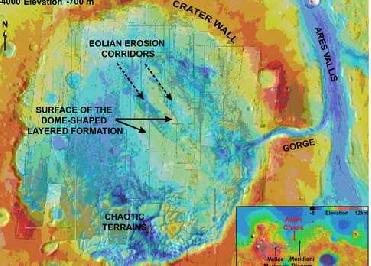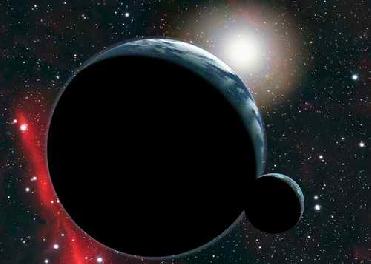
The inset indicates the location of Aram Chaos on a MOLA topographic map of Mars. Credits: NASA/MGS/MOLA/THEMIS
WASHINGTON (BNS): Scientists have been conducting research to find out about past climate on Mars. Data gathered from Mars Express’ OMEGA instrument, the Visible and Infrared Mineralogical Mapping Spectrometer, has revealed that this region shows a significant amount of sulphates and ferric oxides. On Earth, ferric oxide is more commonly known as rust.
In an article ‘Mineralogical composition, structure, morphology, and geological history of Aram Chaos crater fill on Mars derived from OMEGA Mars Express data’ which appears in the Journal of Geophysical Research, the scientists state that they have gathered evidence from the mineralogical composition of the Aram Chaos region, a crater 280 km in diameter lying almost directly on the Martian equator.
“Yet in the dark deposits of Aram Chaos, there is a four-fold increase in the spectral signature of ferric oxides, revealing a specific concentration mechanism. Ferric oxides are generally found with sulphates but, in this case, the lighter sulphates have been blown away, leaving the ferric oxides exposed,” scientists said.
Stephane Le Mouelic, Universite de Nantes, a member of the team who conducted the probe said that they had accumulated dark deposits at the bottom of sulphate cliffs. “This suggests that the ferric oxides had been uncovered by erosion before dropping to the base of the cliffs. The dunes in this region are also enriched in ferric oxides,” he said.
According to researchers this phenomenon was not unique to the Aram Chaos region. “The NASA Opportunity rover discovered ferric oxide deposits in Meridiani Planum, about 1000 km away. The scientists called the deposits 'blueberries', because of their spherical shape. Valles Marineris, 3000 km away, also shows similar deposits. So Mars Express’ detection of ferric oxides in Aram Chaos links together widely separated areas of Mars,” Mouelic said.
Scientists believe that there may even be other regions that have witnessed the same accumulation process but now lie hidden from Mars Express’ view. “OMEGA is sensitive to the first hundreds of microns of the surface. So, a layer of Martian dust just one millimeter thick will hide the signature from us,” Marion Masse, Universite de Nantes, lead author on the paper describing the probe, said. “Fortunately, in many regions of Mars, such as Aram Chaos, wind erosion has blown the dust cover away, leaving bulk rocks exposed,” Masse said.
The scientists are of the opinion that although the true extent and nature of the accumulation process of sulphates and ferric oxides remains elusive, they will now probe the possible hypotheses that could have caused it in the first place. “At this stage, we are ruling nothing out. It could be anything from atmospheric precipitation such as rain or snow, to volcanic ashes or glacial deposits,” they said.
 Previous Article
Previous Article












The Indian Air Force, in its flight trials evaluation report submitted before the Defence Ministry l..
view articleAn insight into the Medium Multi-Role Combat Aircraft competition...
view articleSky enthusiasts can now spot the International Space Station (ISS) commanded by Indian-American astr..
view article